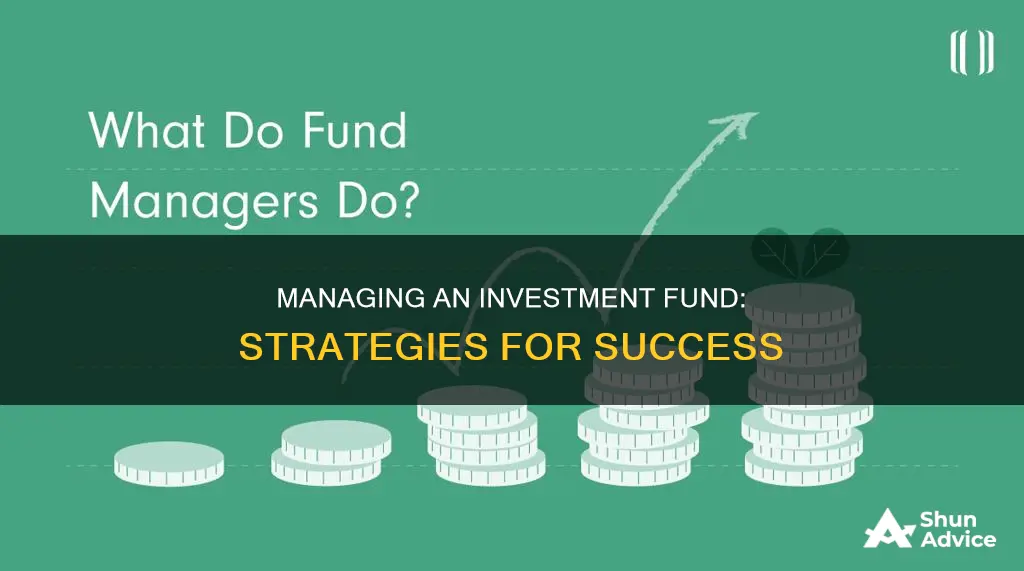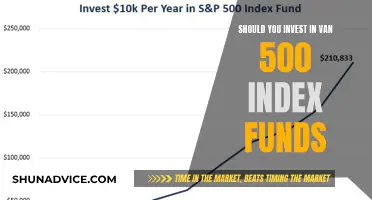
Managing an investment fund is a complex and challenging task that requires a strong understanding of financial markets and investment strategies. Investment fund managers are responsible for overseeing and making decisions about a large pool of liquid assets, with the primary goal of maximising returns for their clients. To achieve this, fund managers employ various investment strategies, conduct in-depth research, and monitor the financial and operational performance of individual investments. They also need to stay up to date with economic trends and industry developments to make informed decisions. Fund managers can be categorised as either active or passive, with active managers taking a more proactive approach by constantly changing their holdings, while passive managers mirror the returns of a benchmark index. Ultimately, the success of an investment fund relies on the fund manager's ability to balance risk and reward effectively.
| Characteristics | Values |
|---|---|
| Role | Implement a fund's investment strategy and manage its portfolio trading activities |
| Education | Highly educated with professional credentials and management experience |
| Types | Active managers, passive managers |
| Investment strategies | Top-down, bottom-up, fundamental analysis, technical analysis, contrarian investing |
| Investment style | Compatible with investors' risk-reward profile |
| Investments | Stocks, bonds, securities |
| Clients | Institutional investors, individual investors |
| Goals | Maximise return on client investments |
| Skills | Analytical, business, math, people, intuition |
What You'll Learn

Monitor financial performance
Monitoring the financial performance of an investment fund is a critical aspect of fund management. It involves tracking the performance of individual investments to ensure that the portfolio meets the risk goals set out.
To effectively monitor financial performance, investment fund managers must maintain a thorough understanding of economic trends and influences. They need to stay up-to-date with the latest developments in the broader economy and specific sectors. This includes reading financial briefings and analysing economic data. By doing so, fund managers can identify potential risks and opportunities for their clients' investments.
Fund managers also need to regularly review the performance of the fund and individual investments. This includes assessing whether the fund is meeting its financial goals and whether the risk levels are in line with the desired targets. If the fund is underperforming or if there are significant changes in the economic landscape, fund managers may need to rebalance the portfolio by adjusting the mix of investments.
Additionally, fund managers should also monitor the performance of individual companies within their portfolio. This can include analysing financial information, meeting with company executives, and assessing the company's position relative to its competitors. By doing so, fund managers can identify companies that are well-positioned for growth or those that may be facing challenges, and make investment decisions accordingly.
Overall, monitoring financial performance is a key aspect of fund management, ensuring that the fund is meeting its financial goals while managing risk effectively. It requires a combination of analytical skills, economic knowledge, and the ability to make informed decisions based on market trends and company-specific factors.
Thematic Funds: Diversify Your Portfolio, Invest in the Future
You may want to see also

Select investments
Selecting investments is a critical aspect of managing an investment fund, and it involves evaluating and choosing specific investments or investment mixes for purchase by the fund. Here are some detailed strategies and considerations for this process:
Top-Down Investing:
Top-down investing involves making investment decisions based on the broader economic landscape and market trends. For example, if a fund manager expects the economy to grow, they may purchase stocks across the board or focus on cyclical stocks in sectors poised to perform well. Conversely, if they anticipate an economic downturn, they may sell stocks or invest in defensive industries like healthcare and consumer staples. This approach focuses on the "big picture" and can help identify sectors and industries with potential. However, it's important to remember that predicting economic trends can be challenging, and correct predictions don't always translate to successful individual investments.
Bottom-Up Investing:
Bottom-up investing takes a more micro-level approach, focusing on the strengths and weaknesses of individual companies rather than the broader economic context. A bottom-up manager will conduct thorough research on a company's financials, management, and growth prospects, often finding attractive investments in sectors that are out of favour. While this strategy can help identify good investments, it may not offer protection during a market-wide downturn.
Fundamental Analysis:
Fundamental analysis is a deep dive into a company's business and financial factors. It involves examining a company's financial statements, meeting with executives and employees, and understanding its competitive position and industry. By analysing these fundamentals, fund managers can make more informed decisions about a company's growth prospects and the potential for its stock to rise.
Technical Analysis:
Technical analysis focuses on an investment's historical trading patterns and price trends. Technical analysts believe that an asset's price at any given moment reflects all available information, and they use charts and data to identify potential buy or sell signals. While this approach doesn't provide insights into the underlying business, it can be a valuable tool for short-term trading decisions and identifying potential turning points.
Contrarian Investing:
Contrarian investing goes against the grain, seeking out-of-favour assets or sectors that the market has overlooked or undervalued. This strategy often aligns with value investing, where assets are purchased based on statistical measures of undervaluation. Contrarian investing can be rewarding, but it also carries the risk of betting against the consensus and losing if the market's assessment is correct.
Diversification:
Diversification is a key principle in investment management. By spreading investments across different sectors, asset classes, and geographic regions, fund managers can reduce risk and improve long-term returns. However, over-diversification can dilute potential gains, so it's important to balance diversification with a focused approach.
Time Horizon:
Considering the time horizon, or investment timeframe, is crucial when selecting investments. For example, money needed in the short term should be invested in safer assets like bonds or certificates of deposit (CDs), while longer time horizons can accommodate higher-risk, higher-return investments like stocks.
Risk and Return:
Fund managers must carefully consider the risk and return profile of each investment. Different investors have varying risk tolerances, and it's essential to match the risk level of the investment with the investor's ability to handle potential losses. Additionally, understanding the potential returns of an investment is vital for ensuring it aligns with the fund's goals and the investor's expectations.
In conclusion, selecting investments for an investment fund requires a combination of strategic thinking, analytical skills, and an understanding of market trends, company fundamentals, and risk management. Fund managers must also tailor their investment choices to the fund's objectives and the specific needs and risk profiles of their clients.
Quantum Fund Investment: Strategies for Success
You may want to see also

Manage analysts
Managing analysts is a key part of a fund manager's role. Fund managers are responsible for overseeing a team of analysts, conducting research, and making important investment decisions.
A fund manager's role is to implement a fund's investment strategy and manage its portfolio trading activities. They are paid a fee for their work, which is a percentage of the fund's average assets under management (AUM). Fund managers are highly educated and often have professional credentials and management experience.
Analysts assist portfolio managers with individual research on investment ideas and subsequent buy, sell, or hold recommendations. After gaining experience and familiarity with fund operations and management style, analysts can build a case for an internal promotion to manager.
Fund managers need to have great business, math, and people skills. They must meet with their team, existing and potential clients, and conduct research on companies, the financial industry, and the economy.
When it comes to managing analysts, fund managers should ensure that analysts have the necessary resources and support to conduct thorough research. They should also provide guidance and direction to analysts, ensuring that their research is aligned with the fund's investment strategy and objectives.
Additionally, fund managers should regularly review and evaluate the performance of analysts, providing feedback and helping them improve their skills. Effective communication and collaboration between fund managers and analysts are crucial for making informed investment decisions.
Overall, the successful management of analysts by fund managers involves providing leadership, fostering a collaborative environment, and ensuring that the research and analysis conducted supports the fund's investment strategy and goals.
Target-Date Funds: A Comprehensive Guide to Investing Wisely
You may want to see also

Conduct research
Conducting research is a key part of managing an investment fund. Fund managers need to research and determine the best stocks, bonds, or other securities to fit the strategy of the fund. This involves evaluating all the business factors that affect an investment's performance, such as analysing a company's financial information, meeting with company executives, employees, suppliers, customers, and competitors, and staying up to date on industry trends.
Fund managers can take different approaches to their research. A top-down investing strategy involves choosing assets based on a macroeconomic theme. For example, a fund manager might buy stocks across the board if they anticipate a sharp economic growth. On the other hand, a bottom-up manager chooses stocks based on the strength of an individual company, regardless of the economic context.
Fund managers also need to decide whether to take an active or passive management approach. Active fund managers try to outperform their peers and benchmark indexes by constantly changing their holdings, whereas passive fund managers mirror the returns of a benchmark index.
Investing in Vanguard: Target Retirement Funds Explained
You may want to see also

Make investment decisions
Making investment decisions is a critical aspect of managing an investment fund. Here are some detailed instructions and considerations for making investment decisions:
Investment Strategies
When making investment decisions, fund managers employ various investment strategies. Two common approaches are top-down investing and bottom-up investing. Top-down investing involves making decisions based on the broader economic landscape and selecting assets that align with anticipated economic trends. For example, a fund manager might purchase stocks across the board if they expect strong economic growth or focus on cyclical stocks in specific sectors. Conversely, they might sell stocks or invest in defensive industries like healthcare and consumer staples if they anticipate an economic downturn. While this strategy provides a macro perspective, it may not always yield accurate results, as the manager's economic predictions could be incorrect, or they might choose the wrong investments within their chosen sectors.
Bottom-up investing, on the other hand, focuses on the performance of individual companies rather than the broader economy. This strategy involves selecting stocks based on a company's strength and growth potential, regardless of economic conditions. Bottom-up investing can help identify good investments, but it may not provide a buffer against market-wide downturns.
Fundamental analysis is another key strategy, which involves evaluating all the factors that can influence an investment's performance. This includes analysing a company's financial information, meeting with key stakeholders, and understanding the broader industry and economic context. This approach helps fund managers predict a stock's future direction by assessing the company's growth prospects.
Additionally, technical analysis is employed by some fund managers, who base their decisions on historical trading patterns and price trends of investments rather than underlying business fundamentals. Many fund managers combine both fundamental and technical analysis to make informed decisions.
Risk Management and Diversification
When making investment decisions, fund managers must carefully consider risk management and diversification. Diversification is a fundamental principle, where investments are spread across different sectors and asset types to reduce risk. Over-diversification, however, can dilute potential profits, so fund managers must strike a balance. They should also consider the time horizon, investing more aggressively in higher-risk, higher-return assets for long-term goals while opting for safer investments for short-term needs.
Active vs Passive Management
Fund managers also differ in their level of activity in managing a fund. Active fund managers aim to outperform their peers and benchmark indexes by constantly monitoring market trends, economic data, and company news. They buy and sell securities proactively to maximise returns but typically charge higher fees. Passive fund managers, on the other hand, mirror a benchmark index and aim to replicate its returns. Passive management is often associated with lower fees and is common with exchange-traded funds (ETFs) and index mutual funds.
Due Diligence and Monitoring
Making investment decisions requires thorough due diligence. Fund managers must conduct in-depth research on companies, including analysing financial information, meeting with stakeholders, and understanding the industry. Monitoring the performance of investments is also crucial. Fund managers need to stay updated on economic trends and industry developments to ensure that their investment portfolios remain aligned with the fund's goals and risk tolerance. Regular reviews and rebalancing of the portfolio help address any deviations from the target asset allocation.
In summary, making investment decisions involves a combination of strategic thinking, risk management, due diligence, and ongoing monitoring. Fund managers employ different approaches to select investments that align with the fund's objectives while managing risk and optimising returns.
A Guide to Unit Investment Trust Funds: Getting Started
You may want to see also
Frequently asked questions
A fund manager is responsible for implementing a fund's investment strategy and managing its portfolio trading activities. They oversee mutual funds or pensions, manage analysts, conduct research, and make important investment decisions.
Fund managers use a variety of investment strategies, including top-down investing, bottom-up investing, fundamental analysis, technical analysis, and contrarian investing. Top-down investing involves choosing assets based on a macroeconomic theme, while bottom-up investing focuses on the strength of individual companies regardless of the broader economic context. Fundamental analysis involves evaluating all the business factors that affect an investment's performance, while technical analysis involves choosing assets based on prior trading patterns. Contrarian managers, on the other hand, go against the market consensus and make bets against it.
It is important to review the fund manager's investment style and ensure it aligns with your own goals and risk tolerance. Diversification is crucial to managing investment risk, but it is important to avoid over-diversification, which can dilute potential returns. Regularly reviewing and rebalancing the fund's portfolio is essential to ensure it remains aligned with the investor's financial goals, risk tolerance, and market conditions. Additionally, active monitoring and staying up-to-date with economic trends and industry changes are key components of successful fund management.







